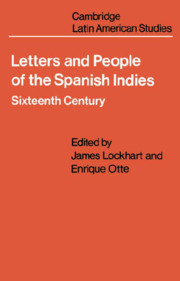Book contents
- Frontmatter
- Contents
- Preface
- Part I Conquest
- 1 Conquest in the personal view
- 2 A standard conqueror's report
- 3 The woman as conqueror
- 4 The merchant and the conquest of Peru
- 5 The merchant and the conquest of Mexico
- 6 The non-hero
- 7 The successful conqueror
- 8 The unsuccessful conqueror
- 9 The conqueror-governor
- 10 The conqueror in jail
- Part II The Variety of Life in the Indies
- Part III officials and Clerics
- Bibliography
- Index
2 - A standard conqueror's report
from Part I - Conquest
Published online by Cambridge University Press: 06 August 2018
- Frontmatter
- Contents
- Preface
- Part I Conquest
- 1 Conquest in the personal view
- 2 A standard conqueror's report
- 3 The woman as conqueror
- 4 The merchant and the conquest of Peru
- 5 The merchant and the conquest of Mexico
- 6 The non-hero
- 7 The successful conqueror
- 8 The unsuccessful conqueror
- 9 The conqueror-governor
- 10 The conqueror in jail
- Part II The Variety of Life in the Indies
- Part III officials and Clerics
- Bibliography
- Index
Summary
Pedrarias de Avila, governor of Tierra Firme, in Panama, to the emperor, 1525
We hear news of great wealth.
It is a shame, in away, that the best-known early official reports from the Indies are Columbus’ hand-waving Italianate pictures of an island paradise, and Cortes’ university prose, elegantly magnifying himself and his conquest. As fine and informative as these writings are, they are not representative of the scores of reports that Spanish leaders sent the crown every year from new areas rich and poor, important and unimportant. There, sobriety and woodenness ruled. Yes, there were bows to the king, and some talk of spreading Christianity, far more than in private letters, and even some mention of marvels of nature and divine intervention, but all in few words, one item after the next, in matter-of-fact, unexcited language corresponding well to the conquerors’ generally Spartan temperament. The message usually went to the basics of whether or not the climate was tolerable for Europeans; whether the Indians were settled and agricultural, capable of sustaining encomiendas and Spanish cities; and whether there was gold, silver or some other product that could subsidize imports from Europe and pay the crown the revenues it desired.
We have chosen the present letter because it has a little of everything; it illustrates the points above, and more. In the second and third decades of the sixteenth century, Tierra Firme and its capital Panama were the clearing house for exploration and conquest in both directions along the South Sea (the Pacific, with the North Sea in this context being the Caribbean). Thus two major conquests appear underway in this letter, that of Nicaragua led by Francisco Hernandez de Cordoba and others, and that of the ‘east’ or Peru led by Pizarro and Almagro. The relay system of conquest, with each new area conquered by people and resources from the immediately preceding one, is seen very clearly here, as well as the tensions that grew out of it. The governor would aid some important citizens in outfitting expeditions which he sent out in his name to add new territories to his own jurisdiction. But the subordinates, who usually took much of the initiative and bore most of the expense, invariably sought independence, and often attained it.
- Type
- Chapter
- Information
- Letters and People of the Spanish IndiesSixteenth Century, pp. 7 - 14Publisher: Cambridge University PressPrint publication year: 1976

